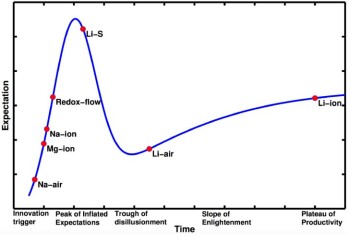Reporting their results in the journal Translational Materials Research, scientists in the US and Germany have monitored research output to assess the prospects for emerging electrical energy storage systems such as Li–air, Li–sulphur and Na–air.
“The reliance of modern electronics and vehicular transportation on rechargeable batteries does not guarantee the acceptance of any new system, even if it is more energy-dense,” caution the authors in their paper. “Cooperation between battery manufacturers and device manufacturers will be important, as will be the creation and support of a dependable supply chain to ensure consistent and sustainable delivery of raw materials of high quality.”
Technology tracking
To quantify the status of emerging rechargeable battery technologies, the researchers examined the popularity of each system within the scientific community based on year-by-year publication statistics. From the data, the team was able to identify critical points such as the ‘innovation trigger’ and other characteristic development phases.

Hype chart derived from publication data showing the status of current and emerging high-energy-density battery systems. A typical technology goes through five phases as it matures and products cycle through different iterations: (i) innovation trigger, (ii) peak of inflated expectations, (iii) trough of disillusionment, (iv) slope of enlightenment and (v) plateau of productivity.
Full details
To find out more about battery design, development and the fundamental materials challenges, view –
Quantifying the promise of ‘beyond’ Li–ion batteries – Oleg Sapunkov et al 2015 Transl. Mater. Res. 2 045002.
Related stories on TMR+
– $5 million investment in Angstron Materials accelerates graphene commercialization

The other day, while I was at work, my cousin stole my
iphone and tested to see if it can survive a forty foot drop, just so she can be a youtube sensation. My apple ipad is now destroyed and
she has 83 views. I know this is completely off topic but I had to share it with someone!
I am in fact thankful to the owner of this web site who
has shared this impressive article at here.